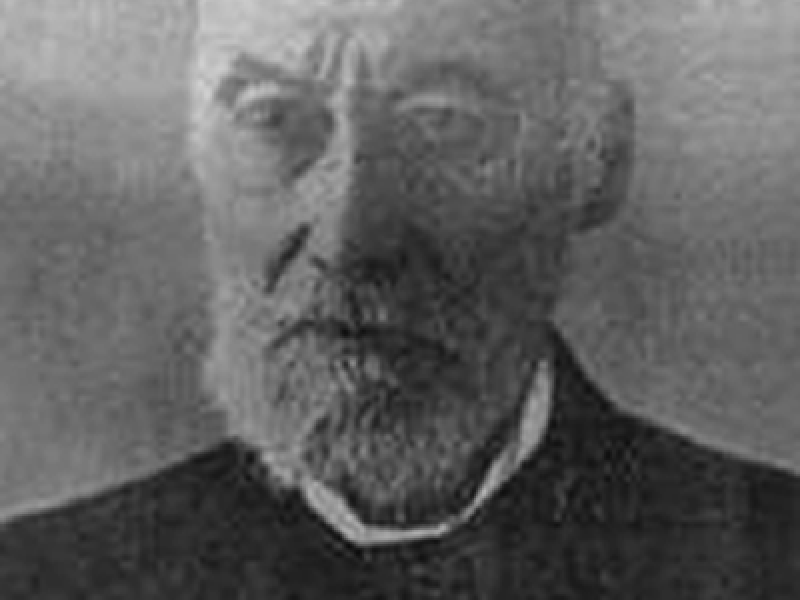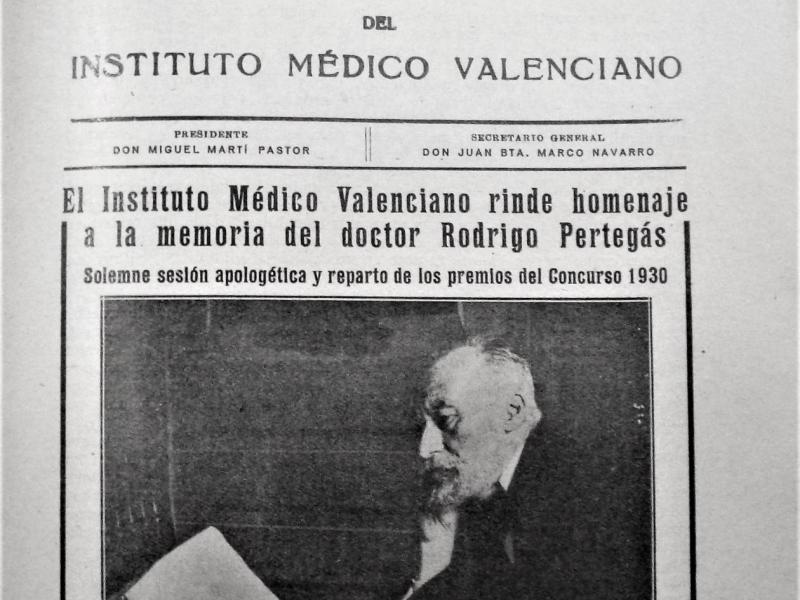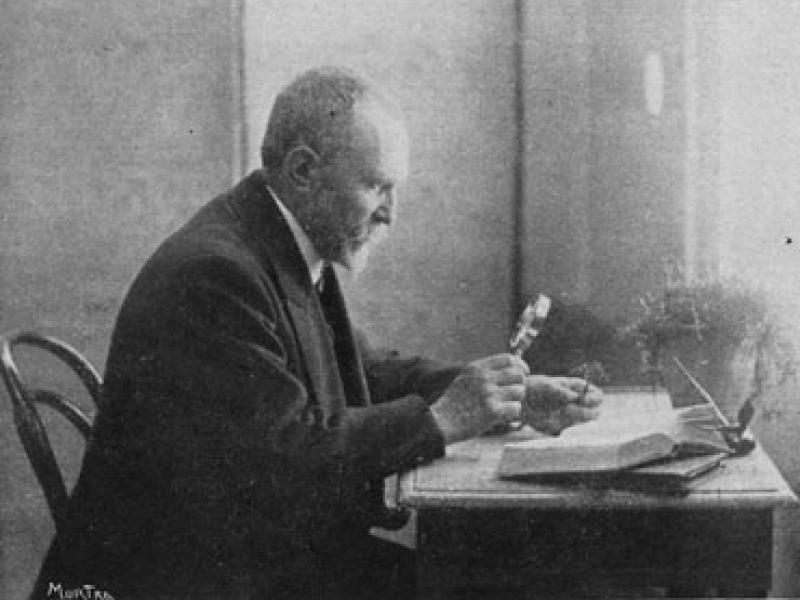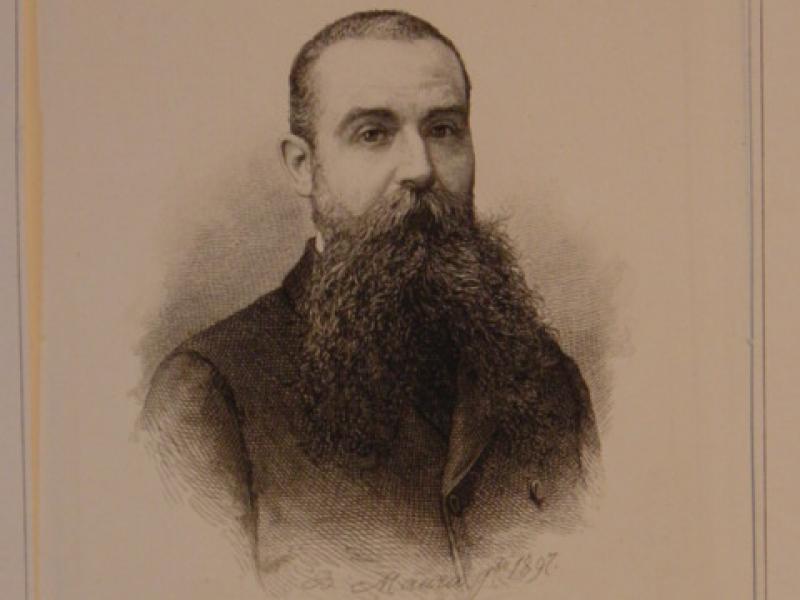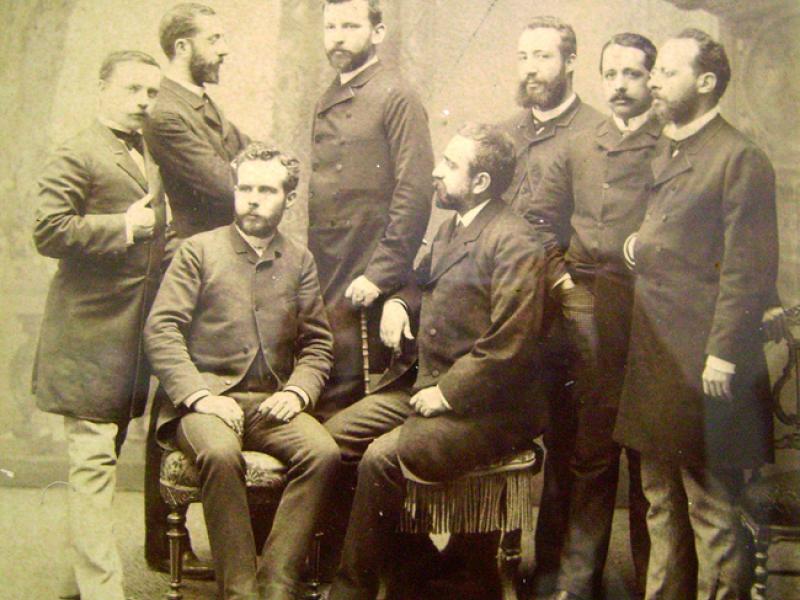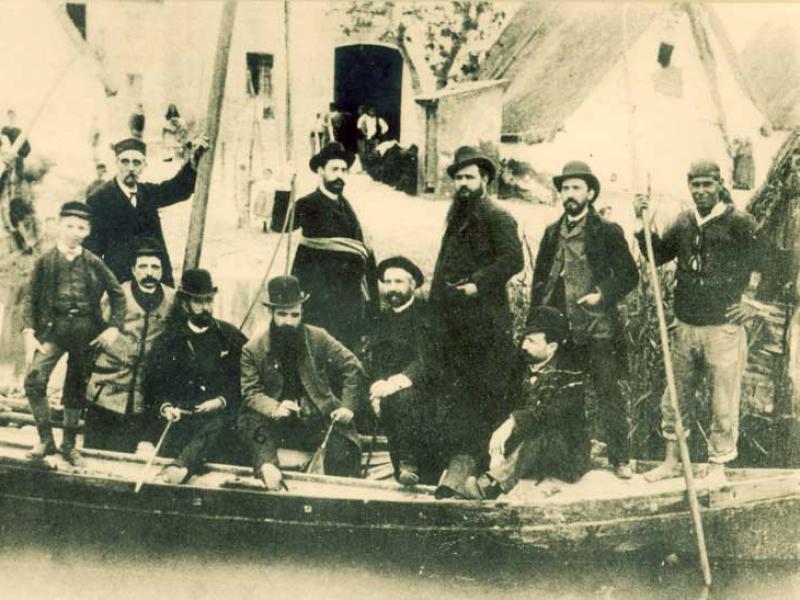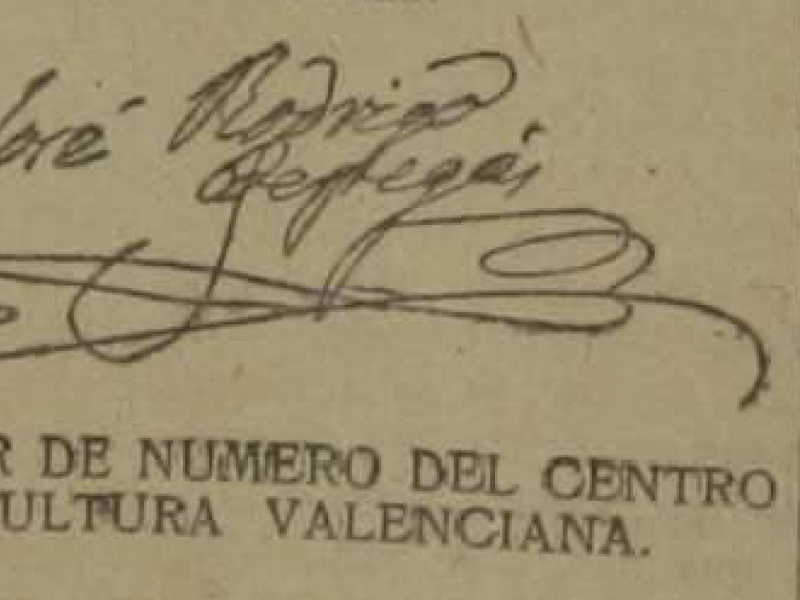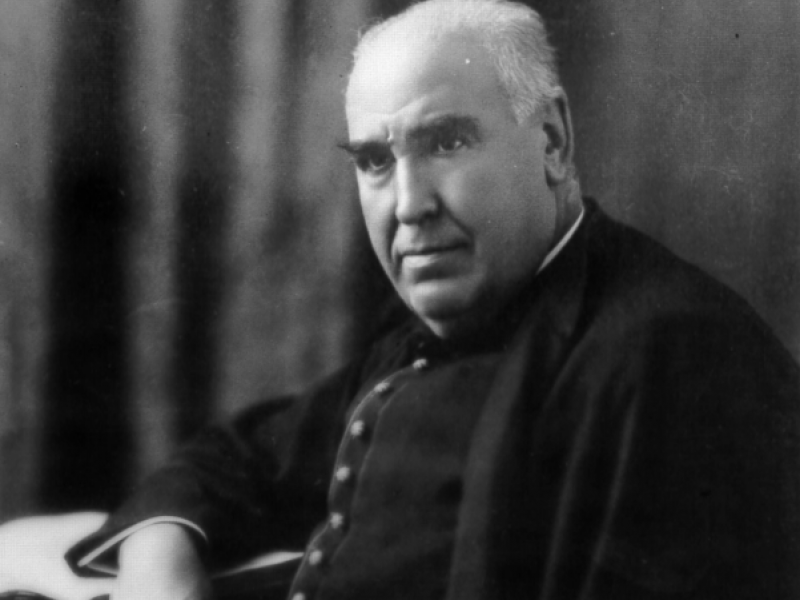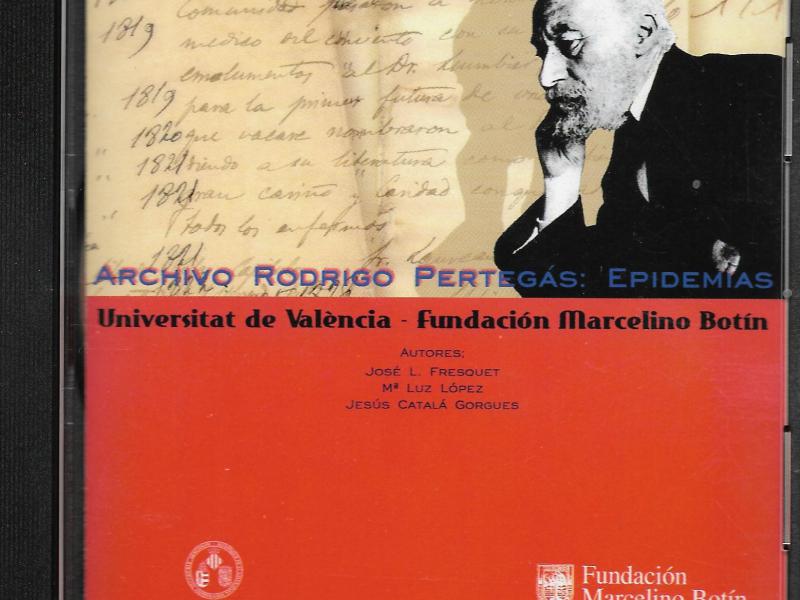Josep Rodrigo Pertegàs (1854-1930)
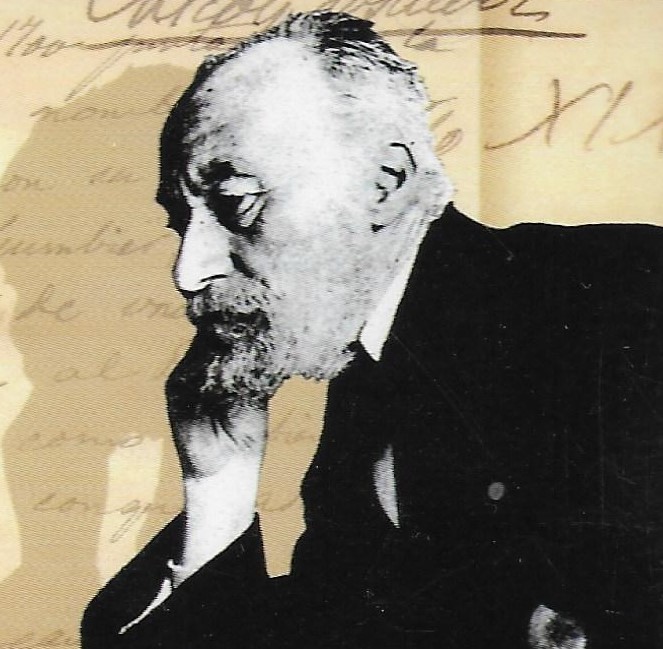
Josep Rodrigo Pertegàs (Valencia, 14 March 1854 – 4 April 1930) was a doctor, naturalist and historian from Valencia, a polymath in the fullest sense of the word. His family came originally from Aragon. His father, Vicente Rodrigo Fuertes, was a lawyer and eventually became the chief administrative officer in the secretariat of Valencia City Council. His mother, Mariana Pertegàs Teruel, was born in Valencia.
After he finished his secondary school studies at the Escoles Pies in Valencia – a school run by the Piarists, or Escolapios, a religious order of clerics regular of the Catholic church dedicated to education, and the cradle of Valencianism, more of a cultural social movement than a political one, whose aim was to preserve and promote the recognition of the linguistic and cultural personality of the Valencian Country – he studied medicine at the faculty in Valencia, where he graduated on 28 September 1875. In September 1876 he was appointed as a general practitioner in Alcublas (a town 52 kilometres from Valencia) and he worked there for a year. His delicate state of health – which was a constant feature throughout his entire life – was an important obstacle, but it was in actual fact his mother’s death and the need to go and attend to the matter of his inheritance that forced him to return to Valencia.
There, he worked for the city council in various posts. However, in January 1877, he moved to Villar del Arzobispo (very close to Alcublas and 55 kilometres from Valencia) to help out in the fight against trichinosis. He was subsequently attached to the municipal welfare medical corps in Valencia, then appointed head of the Clothes Disinfection Service and a doctor at the Llatzaret de Sant Pau, where people were quarantined, and later the doctor of the municipal police force (1890). He laboured intensely in the struggle against the cholera epidemic of 1890, for which he was awarded the municipal medal of merit, created for the occasion. On 5 August 1891 he was appointed a member of the Provincial Board of Health.
Despite all this, Rodrigo Pertegàs gradually abandoned clinical practice in order to devote himself to historical research, but his links to the medical profession in Valencia were always strong. Not long after establishing his residence in Valencia he was made a member of the Instituto Médico Valenciano (Valencian Medical Institute), a non-academic institution founded in 1841, which did commendable work in the second half of the nineteenth century. Rodrigo Pertegàs was a member of the body’s board of governors on several occasions. The Institute’s Boletín (gazette), published between 1841 and 1896 (and later incorporated into the Boletín de la Unión Sanitaria Valenciana), was the most important medical journal in the Valencian Country, and one of the most outstanding in Spain, which acted as an effective platform for the dissemination of new developments that were arriving from Europe and was a true reflection of medical life in Valencia.
Involvement in the world of culture, religious belief and political Valencianism
Rodrigo Pertegàs was comfortably off financially, and this ensured him a certain degree of social influence, seen in his membership of many associations: the Círculo de Bellas Artes de Valencia, the Sociedad de Agricultura and the Centro de Cultura Valenciana (of which he was the director from 1915). In 1895 he joined the board of directors of Lo Rat Penat (a Valencian cultural association), but, although he had close ties with ratpenatisme, he always kept a low profile and did not play too great a part in the institution. He was also a corresponding member of the Reial Acadèmia de Bones Lletres de Barcelona (from 1901) and a full member of the Reial Acadèmia de Medicina de València (from 1922).
The scholars who were part of cultural Valencianism, especially with regard to historiography, were often politicians or men who held posts unrelated to teaching and historical research, for instance doctors or clergymen. With them, history in general and the history of medicine in particular were placed at the service of an ideal and a project of cultural and scientific recovery and regeneration, and also of the revival of a hidden or unknown language (the form of Catalan spoken in Valencia, called Valencià).
He also did very important work from the Valencianist circle in Castelló de la Plana revolving around the Sociedad Castellonense de Cultura and its Boletín. This society was founded in 1919 with bourgeois and Catholic leanings, similar to the ones appearing in Valencia. Rodrigo Pertegàs remained a very close friend of some of its members.
Of note is our doctor’s interest in collecting all kinds of things related to folklore and ethnology (sayings, songs, games, festivities, and so on), without doubt, a vivid demonstration of his commitment to everything that had to do with culture in Valencia. Rodrigo Pertegàs belonged to the Gaster-Club, a sporting and gastronomic society founded by Santiago Ramón y Cajal, a friend of his. With its members he went on leisure and cultural excursions, which after Cajal’s departure continued with the botanist Vicent Guillén i Marco. All these activities revealed a certain interest on his part in fighting for the preservation of the architectural, archaeological and anthropological heritage of Valencia.
One characteristic that always defined Rodrigo Pertegàs was his deeply held religious belief. He was a member of numerous religious confraternities and associations, in which he took an active part. He moreover had many friends among the clergy, outstanding among them the canon and historian Josep Sanchis Sivera (1867-1937), who would be the executor of his will. One must remember that in the closing stages of the nineteenth century, and spurred on by Pope Leo XIII’s encyclical Rerum novarum (1889), an important Catholic movement arose that was interested in social problems, and which became well established in Valencia. Rodrigo Pertegàs felt a strong adherence to these principles, which inspired one of his most ambitious works, but which never saw the light of day: the history of labour and of the workers’ movement in the Valencian Country. It was a work that, written in Valencian, he hoped to present at the Jocs Florals (a literary competition) of 1892, organized by Lo Rat Penat with the support of Valencia City Council, entitled Estudi crítich sobre l'estad social y econòmich de les clases obreres en València, desde els temps forals fins a nostres dies (A critical study of the social and economic state of the working class in Valencia, from the time of the furs [medieval laws] to the present day).
His dedication to history
The list of scholars, historians and those interested in culture who had dealings with Rodrigo Pertegàs is surprising. He was an important figure in cultural circles in Valencia at the turn of the century. He exchanged a great deal of correspondence with some eminent scholars of the old Crown of Aragon and this clearly points to a relationship in which he offered his services as an eminent palaeographer and an expert on the documentation in all the archives and libraries in the city of Valencia. It is no surprise that Francesc de Borja Moll should have made him an active collaborator on the Diccionari Català-Valencià-Balear, as he clearly states in the work’s introduction.
Over time, historical research eventually became for him an authentic obsession and an absorbing task, which left him virtually no time for anything else. His way of understanding history has to be linked to the teachings of the canon from Dénia, Roc Chabàs, the master of a generation of scholars and historians from Valencia. A methodical researcher, he was the first to resort to the archive sources, and even the archaeological ones, in order to answer many specific questions about the history of Valencia in which there was next to no interest. Grand synthesis, the only way of studying history that was then understood in the universities, and a methodology condemned by the scant documentary data known up to then, was thus abandoned.
Rodrigo Pertegàs was not unaware of the historiographical trends in Europe. On one hand, his knowledge of foreign languages, French and German to be exact, enabled him to translate various scientific works. On the other, the most up-to-date titles on the subjects that interested him were to be found in his library. What is more, among his notes there are mentions of the bibliography of the history of medicine in different countries, and a section of his archive is dedicated to “Historiography and Bibliography”. What is beyond doubt is his wish to make contact with the European movement that originated the history of medicine, and from a positivist perspective that Rodrigo Pertegàs fully shared.
Medicine in medieval Valencia
In the course of more than 25 years, which he spent among the bundles of the archives and libraries of Valencia, Rodrigo Pertegàs amassed a huge quantity of handwritten notes. These papers, most of which have survived, include personal and professional details of all the medical practitioners that interested him and which he gradually located during his years as a researcher. They were from all periods, but especially the Middle Ages. All this work was done for a great personal project: to produce a biographical dictionary of all the individuals who, since the medieval period, had worked in medicine in Valencia.
Moreover, his predilection for the Middle Ages is unquestionable. Beyond the importance that this period has, as has been said, in the documents that he amassed, most of his publications refer to it. His attraction for medievalism must therefore have been very great. On one hand, that period in history witnessed the foundation of the country, with the establishment of the kingdom of Valencia, and in literary history above all, the names of the great national authors resounded. On the other hand, as was the case in the European context and in Catalonia too, the nineteenth-century bourgeoisie – of which historians like Rodrigo Pertegàs were members and were its intellectual spearhead – sought legitimation in an idealized later Middle Ages that had witnessed the birth of the bourgeoisie, and in which this social group gained access to the governing, cultural and scientific elite, and were responsible for very important changes in it.
As a good historian of this period, he systematically resorted to biographical bibliographies, from the one by Nicolás Antonio to those specializing in the history of medicine, in particular those by Antonio Hernández Morejón, Anastasio Chinchilla and León Sánchez Quintanar, but also to other local ones like those by Vicent Ximeno, Josep Rodríguez and Just Pastor Fuster. Therefore, in virtually all the doctors that he studied whose written work has survived he included a file with the references to the biographical bibliographies in which they appeared.
Thanks to initiatives like this, the study of medieval and Renaissance doctors became a key part of a legitimizing past that it was necessary to defend. Thus, he showed how the noble profession of doctor had been previously exercised very successfully and how its practitioners enjoyed great prestige. What is more, he corrected the biased view in his day of Valencia’s medieval ancestors. Rodrigo Pertegàs saw in medieval Valencia – as Lluís Comenge, with whom he exchanged scholarly correspondence for many years, and Josep Maria Roca both saw in Catalonia – an admirable medical and health care system, worthy of being imitated, full of great figures to extol. An idealized medical world, no doubt, but one that they showed far more closely and faithfully than many other doctors interested in the history of their own profession have done since.
In short, the works of Rodrigo Pertegàs, Comenge and Roca initiated a profound renewal of the history of medicine to Valencia and Catalonia. Following the example of Karl Sudhoff in Germany, they based knowledge on research and analysis of the sources, and in doing so they incorporated discipline to the academic rigour of new positivist history.
Among his most important historical and medical publications are the biography of the sixteenth-century doctor from Valencia, Vicent Garcia Salat (1896), a biographical study of the medieval doctor Domingo Ros d’Ursins (1902), another one about the male and female apothecaries of Valencia in the fifteenth century, a study of morbo gallico (syphilis, or the “French disease”) in Valencia in the fifteenth and sixteenth centuries (1922), and another about the hospitals of Valencia in the fifteenth century (1927).
But he was not only interested in the history of medicine. Rodrigo Pertegàs gathered information about a great many subjects and illustrious figures virtually unknown at that time. His production comprises a large number of individual works, generally brief, appearing in different periodical publications: the Almanaque de 'Las Provincias', the Revista Valenciana de Ciencias Médicas, the Diario de Valencia, the Anales del Centro de Cultura Valenciana and the Boletín de la Real Academia de la Historia. He only published a few books. One of them is Historia de la antigua y real cofradía de Nuestra Señora de los Inocentes Mártires y Desamparados, de la veneranda imagen y de su capilla (‘History of the royal and ancient confraternity of Our Lady of the Innocent Martyrs and the Abandoned, of the revered image and of its chapel’, 1922), his most far-reaching work. This book received a great deal of praise in the form of letters and articles. It must have been very gratifying for him, in those years just when he had gone blind. Nor should we forget La judería de Valencia (‘The Jewish Quarter of Valencia’, 1913) and his Ensayo sobre topografía preurbana de Valencia (‘Essay on Valencia’s Pre-urban Topography’, 1922).
The bibliographical and documentary legacy
After his death the executor of his will, Josep Sanchis Sivera, had to decide what to do with the historian’s enormous legacy. His niece, who had looked after him until the end – Rodrigo Pertegàs never married – entrusted the decision to the learned clergyman. The canon, seeing that in Valencia there would be no one interested in safeguarding his private library, sold it to the Biblioteca de Catalunya, where his books are still kept. It should be pointed out that, along with the personal library, a series of bound volumes arrived in Barcelona that contain handwritten research notes by the historian (vegeu Biblioteca manuscrita de Rodrigo Pertegàs), and that Sanchis Sivera, as we shall see, kept part of the research material for himself.
The large personal archive, with the main body of the research papers and a lot of other material, remained in the family home in Valencia. Only after the flood of 1957 did this collection resurface, when it was sold. José María López Piñero, the first professor of the history of medicine at the Universitat de València, managed to purchase it. It was thanks to the example of Rodrigo Pertegàs, now verifiable in detail, that López Piñero and Luis García Ballester, his first disciple and friend, would undertake the study of the history of medicine and its practitioners in the old kingdom of Valencia, subsequently extending it to the whole of the old Crown of Aragon. The archive was deposited in the Universitat de València’s Institut d’Història de la Medicina i de la Ciència, and a magnificent, useful, complete digital edition was later published on eight compact discs (Archivo Rodrigo Pertegàs, 2002-2003).
However, we now know that this was only one part of his huge legacy. Another part of the research archive, with the personal correspondence and other papers, has been found in the library at the Universitat de València. And yet another part, more modest, has been located in the Biblioteca Valenciana, in the collection of Manuel Sanchis Guarner, the nephew of Josep Sanchis Sivera (folders about confectioners and sweet makers, a topography of Valencia, the hospital of Sant Antoni, and various things). In these two cases, however, the cataloguing of the material is non-existent or very imprecise.
Rodrigo Pertegàs was a deeply humble man who played an important role in the intellectual life of Valencia, and he contributed a substantial cultural legacy, always moved by a love for the land of his birth. Consultation of his writings continues to be essential, because his dedication to research in numerous archives in Valencia and the network of contacts with scholars of the old Crown of Aragon, and further afield, enabled him to build up knowledge of the sources and their unpublished handling up to then. Without a doubt he is one of the fathers of the history of medicine in the old Crown of Aragon, and particularly the old Kingdom of Valencia.
To find out more
- Crespo i Martínez, Jaume, "Josep Rodrigo i Pertegàs", dins Memoriavalencianista.cat: la hiperenciclopèdia històrica del valencianisme
- Ferragud, Carmel - López Terrada, María Luz, "El culte al document: l'historiador valencià Josep Rodrigo Pertegàs", Afers, en premsa
- Fresquet Febrer, José Luis - López Terrada, María Luz, “La digitalización del Archivo Rodrigo Pertegás de la Biblioteca y Museo Historicomédicos de la Universitat de València”, dins Josep Batlló Ortiz, Pasqual Bernat López, Roser Puig Aguilar (eds.), Actes de la VII Trobada d'Història de la Ciència i de la Tècnica (Barcelona, 14, 15, 16 i 17 de novembre de 2002), Barcelona, Societat Catalana d'Història de la Ciència i de la Tècnica, filial de l'Institut d'Estudis Catalans, 2003, pp. 349-355
- Fresquet Febrer, José Luis - López Terrada, María Luz (dirs.), Archivo Rodrigo Pertegàs, València - Santander, Instituto de Historia de la Ciencia y Documentación López Piñero (Universitat de València-CSIC) - Universitat de València: Departament d'Història de la Ciència i Documentació / Biblioteca y Museo Historicomédicos - Fundación Marcelino Botín, 2002 - 2003, 8 CD-ROM
- Gascón Pelegrí, Vicente, "Rodrigo Pertegàs, José. Médico e historiador", dins Ídem, Prohombres valencianos en los últimos cien años. 1878-1978, València, Caja de Ahorros de Valencia (Monografías del centenario. 1878-1978), 1976, pp. 306-308
- Gómez[-Ferrer] Martí, Pedro, El investigador histórico y médico valenciano D. José Rodrigo Pertegás, València, Tip. Moderna, 1923
- Gómez-Ferrer Martí, Pedro, "Discurso apologético en honor del médico y polígrafo D. José Rodrigo Pertegás", Boletín del Instituto Médico Valenciano, 11/105 (des. 1930), 32-37
- Gran Enciclopèdia Catalana, Barcelona, Enciclopèdia Catalana, vol. 12, 1978, p. 682
- Gran Enciclopedia de la Región Valenciana, València, Gran Enciclopedia de la Región Valenciana, vol. 10, 1973, p. 73
- Igual Úbeda, Antonio, Historiografía del arte valenciano, València, Institución Alfonso el Magnánimo - Caja de Ahorros de Valencia, 1956, pp. 156-158
- Martí Oltra, Javier, "Rodrigo i Pertegàs, Josep", dins Diccionari d’historiografia catalana, Barcelona, Enciclopèdia Catalana, 2003, pp. 1020-1021
- Sanchis Sivera, Josep, “Ha fallecido el doctor don José Rodrigo Pertegás”, Diario de Valencia (05/04/1930)
Captions and provenance of the illustrations
1. Portrait of Josep Rodrigo Pertegàs in the last years of his life (Memòria valencianista).
2. Tribute to Josep Rodrigo Pertegàs in the Boletín del Instituto Médico Valenciano (December 1930).
3. Vicent Guillén Marco (1853-1913) was a doctor in the city of Valencia interested in botany. He was a friend of Rodrigo Pertegàs, with whom he went on many excursions to collect minerals and gather plants (Historia de la medicina).
4. Faustí Barberà Martí (1850-1924) was an eminent doctor from Valencia, associated with the political and cultural Valencianism of the Renaixença. He remained close friends with Rodrigo Pertegàs, who was to write a very well researched biography of this figure (print by Bartomeu Maura, 1897).
5. The doctor Jaume Ferran i Clua seated (right) among other colleagues who advocated the cholera vaccine, in 1885. Rodrigo Pertegàs was noted for his work during the epidemic in the city of Valencia. Lluís Comenge i Ferrer (1854-1916) appears standing on the far left, a fellow student of Rodrigo Pertegàs in his graduation year and with whom the latter exchanged correspondence for many years, related to their common interest in the history of medicine (Museu d’Història de la Medicina de Catalunya).
6. Photograph taken by Santiago Ramón y Cajal (1852-1934) in the Albufera of Valencia, perhaps El Palmar, during an excursion by the Gaster-Club, of which Rodrigo Pertegàs was also a member. Cajal and Rodrigo Pertegàs were friends during the time that the famous histologist was a professor at Valencia (1883-1887) (Valencia Historia Gráfica 2).
7. One of his archive notes, in this case about the professions of confectioner and sweet maker in the fifteenth century (Biblioteca Valenciana, Manuscrits, AMSG.FJSS 41)
8. The signature of Josep Rodrigo Pertegàs (Diario de Valencia, 28/04/1919).
9. Josep Sanchis Sivera (1867-1937), a close friend and the executor of Rodrigo Pertegàs’ will (Biblioteca Històrica de la Universitat de València).
10. Cover of one of the CD-ROMs of the Archivo Rodrigo Pertegàs.
Bibliography of Josep Rodrigo Pertegàs
Contents
I. History of medicine and science
II. History of Valencia
III. Historiy of culture
IV. Historiy of urbanism
V. Other publications
VI. Translations
I. History of medicine and science
- "Apología del Dr. D. Vicente García Salat: discurso leído en la apertura del curso de 1896-97 del Instituto Médico Valenciano (Colegio oficial)", Boletín del Instituto Médico Valenciano, 26 (1896), 1-40 [tiratge a part: València, Impr. Manuel Alufre, 1896, 40 pp.]
- [amb el pseudònim de Patricio],"Efemérides médico-valencianas", Revista Valenciana de Ciencias Médicas, vol 1, núm. 2 (febrer 1899), pp. 29 i 60-62
- [amb el pseudònim de Patricio], "Efemérides médico-valencianas", Revista Valenciana de Ciencias Médicas, vol 1, núm. 3 (març 1899), pp. 92-95
- [amb el pseudònim de Patricio], "Efemérides médico-valencianas", Revista Valenciana de Ciencias Médicas, vol 1, núm. 4 (abril 1899), pp. 122-125
- Higiene pública en Valencia en los siglos XV y XVI: conferencia leída en el Instituto Médico Valenciano, en 11 de mayo de 1899, València, Impr. Manuel Alufre, 1899
- [amb el pseudònim de Patricio], "Efemérides médico-valencianas", Revista Valenciana de Ciencias Médicas, vol 1, núm. 7 (juliol 1899), pp. 210, 218-221 i 348
- [amb el pseudònim de Patricio], “Efemérides médico-valencianos”, Revista Valenciana de Ciencias Médicas, vol. 2, núm. 11 (maig 1900), pp. 154-157, i núm. 18 (setembre 1900), pp. 187-189
- [amb el pseudònim de Patricio], "Efemérides médico-valencianas", Revista Valenciana de Ciencias Médicas, vol 2, núm. 17 (maig 1900), pp. 154-157
- [amb el pseudònim de Patricio], "Efemérides médico-valencianas", Revista Valenciana de Ciencias Médicas, vol 2, núm. 18 (juny 1900), pp. 187-189
- Sobre la higiene pública en Valencia durante los siglos XIV y XV: discurso leído en la apertura del curso de 1900-01 del Instituto Médico Valenciano, València, Impr. Manuel Alufre, 1900
- [amb el pseudònim de Patricio], "La triaca en Valencia", Revista Valenciana de Ciencias Médicas, 26 (1901)
- Recuerdo apologético del maestro de medicina Domingo Ros de Ursins, archiatro de los reyes de Aragón: discurso leído el día 18 de octubre de 1902 en el Instituto Médico-Valenciano en el acto de la apertura del curso por el socio José Rodrigo Pertegás, València, Impr. Manuel Alufre, 1902, 35 pp.
- "Los 'saludadors' valencianos en el siglo XVII", Revista Valenciana de Ciencias Médicas, 8 (1906), 219-220
- “El doctor Plaza en Valencia”, dins Linneo en España: Homenaje á Linneo en su segundo Centenario, 1707-1907, Saragossa, Tip. Mariano Escar, 1907, pp. 403-408
- Mal de sement. Discursos leídos en la Real Academia de Medicina de Valencia en el acto de la recepción pública del académico electo D. José Rodrigo Pertegás el día 31 de diciembre de 1922. Discurso de contestación por Vicente Peset y Cervera, València, Tip. Hijos de F. Vives Mora, 1922, 78 pp.
- “Hospitales de Valencia en el siglo XV: su administración, régimen interior y condiciones higiénicas”, Boletín de la Real Academia de la Historia, 90 (1927), 561-609 [tiratge a part: Madrid, Tip. De la Revista de Archivos, Bibliotecas y Museos, 1927, 49 pp.]
- "El mal de bubas en Valencia a mediados del siglo XV", Anales Centro Cultura Valenciana, 1/2 (1928), 143-149
- "De re militari", Anales del Centro de Cultura Valenciana, 2 (1929), 63-65
- “Boticas y Boticarios: materiales para la historia de la Farmacia en Valencia en la Centuria décima-quinta”, Anales del Centro de Cultura Valenciana, 2 (1929), 110-153
- “Disposiciones contra los sortilegios y artes mágicas”, Almanaque de 'Las Provincias' (1929), pp. 175-176
- "Efemérides notariales”, Anales del Centro de Cultura Valenciana, 3/7 (1930), 191-201; i 4/8 (1931), 1-20 [publicació pòstuma, a càrrec de Josep Sanchis Sivera]
II. History of Valencia
- “Juegos incultos en las calles”, Almanaque de 'Las Provincias' (1918), pp. 189-191
- "Memoria histórica de la T. O. Franciscana de Valencia", dins Asamblea de los Terciarios Franciscanos de Valencia, celebrada en la iglesia de San Lorenzo el día 20 de febrero de 1915, València, Escuela Tipográfica Salesiana, 1918, pp. 19-40
- Historia de la antigua y real Cofradía de Nuestra Señora de los Inocentes Mártires y Desamparados de la venerada imagen y de su capilla, València, Tip. Hijos de F. Vives Mora, 1922, xii + 537 pp.
- “Para la historia de la agricultura y de la industria valenciana”, Almanaque de 'Las Provincias' (1926), pp. 383-384
- “La campana del foch”, Almanaque de 'Las Provincias' (1927), pp. 157-158
- "Un asilo de mendicidad en el siglo XIV", Almanaque de 'Las Provincias' (1932), pp. 155-157
III. History of culture
- “Un fragmento de la traducción valenciana de la Biblia”, Almanaque de 'Las Provincias' (1913), pp. 273-275
- “De re bibliografica: sobre la primera edición de la Doctrina del P. Vives”, Almanaque de 'Las Provincias' (1920), pp. 271-273
IV. History of urbanism
- “La judería de Valencia”, apèndix a l’obra de Josep Sanchis Sivera, La iglesia parroquial de San Esteban (Santo Tomàs), València, Tip. Hijos de F. Vives Mora, 1913, pp. 245-267 [tiratge de 50 exemplars] [reimpr. facs.: València, Librerías París-Valencia, 1992]
- “Las tres capillas de la Virgen”, Diario de Valencia (11/05/1919)
- “¿Cómo sería la Casa Natalicia [de san Vicente Ferrer] en 1350?", Diario de Valencia (28/04/1919), pp. 6-7 del suplement
- Ensayo sobre topografía preurbana de Valencia, Madrid, Tip. de la Revista de Archivos, Bibliotecas y Museos, 1922, 69 pp. [reimpr. facs.: València, Librerías París-Valencia, 1993]
- "La urbe valenciana en el siglo XIV: estudio de investigación histórica sobre las modificaciones que en su topografía ha sufrido la ciudad de Valencia en el último cuarto del siglo XIII y en todo el transcurso del XIV", dins III Congrés d'Història de la Corona d'Aragó, dedicat al periode compres entre la mort de Jaume I i la proclamació del Rey Don Ferrán d'Antequera [València, 1923], València, Diputació Provincial de València - Ajuntament de València, 1923, vol. 1, pp. 279-374 [tiratge a part: València, Diputació Provincial de València - Ajuntament de València, 1924, 100 pp.]
- “La morería de Valencia: ensayo de descripción topográfico-histórica de la misma”, Boletín de la Real Academia de la Historia, 86 (1925), 229-251 [tiratge a part: Madrid, Tip. de la Revista de Archivos, Bibliotecas y Museos, 1925, 27 pp.]
- “De topografía urbana pretérita: el portal de la Boatella”, Almanaque de 'Las Provincias' (1930), pp. 259-260
- “Topografía prehistórica de Valencia”, Almanaque de 'Las Provincias' (1935), pp. 209-212 [publicació pòstuma]
V. Other publications
- "Dr. D. Pedro Chiarri Llobregat. Necrología", Revista Valenciana de Ciencias Médicas, 6/69 (gener 1904), 43-48
- [amb el pseudònim de Patricio], "El Dr. Guillén y Marco. Necrología", Revista Valenciana de Ciencias Médicas, 15 (1913), 67-74
- "Acta de la velada científico-literaria celebrada por el Instituto Médico Valenciano en el día 4 de los corrientes para honrar la memoria del que fué su distinguido socio de mérito Dr. D. Vicente Guillén y Marco", Revista Valenciana de Ciencias Médicas, 16/316 (25 abril 1914), 137-158 [participació de Rodrigo Pertegàs: pp. 145-147]
- Rábena Miriabat, Frutos [pseudònim de Faustí Barberà Martí], "Homenaje póstumo al Dr. Villanueva", Revista Valenciana de Ciencias Médicas, 17/343 (juny 1915), 165-168 ["fue concedida la palabra al conocido escritor y representante del Instituto Médico Valenciano, Sr. D. José Rodrigo Pertegás, quien leyó el siguiente discurso"]
- "Discurso necrológico del Dr. Faustino Barberá Martí", Anales del Centro de Cultura Valenciana, 2/3 (1929), 24-34
VI. Translations
- Pinard, Adolphe - Wallich, Victor, Tratamiento de la infección puerperal, València, Pubul y Morales, 1903, 298 pp. [Traitement de l'infection puerpérale, París, G. Steinheil, 1896]
Carmel Ferragud 2017, 2020
Acknowledgements: Lluís Cifuentes, Mateu Rodrigo
